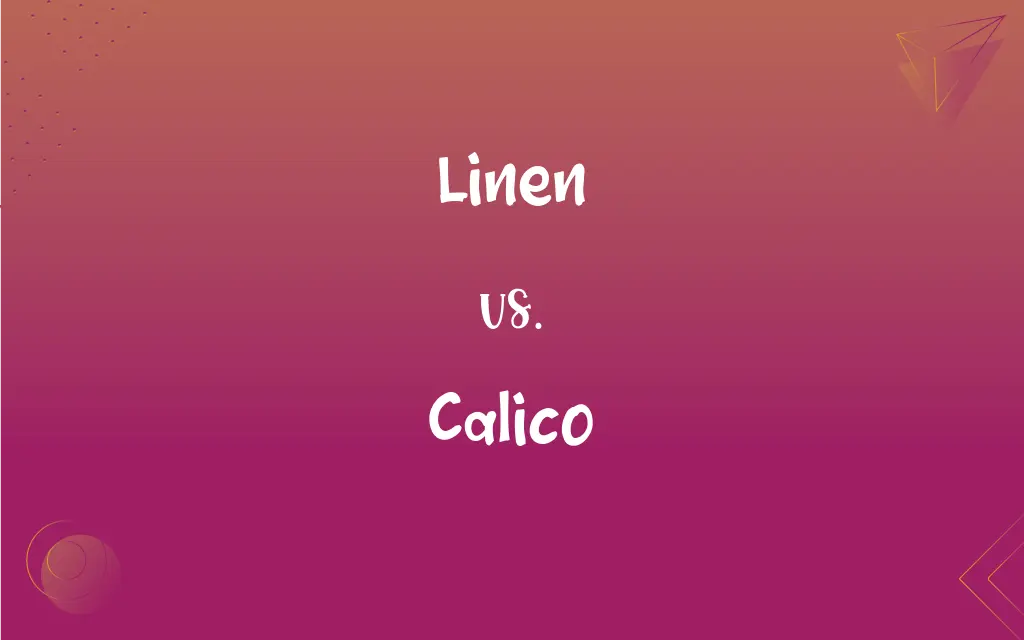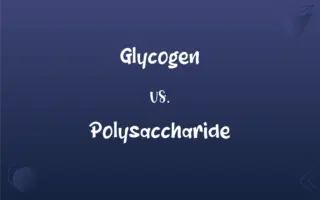Linen vs. Calico: What's the Difference?
Edited by Aimie Carlson || By Harlon Moss || Updated on November 7, 2023
Linen is a textile made from flax fibers, while calico is a plain-woven cotton fabric that is often unbleached and not fully processed.

Key Differences
Linen is known for its strength, smoothness, and lustrous finish, making it a luxury fabric for clothing and home textiles. Calico, by contrast, is a more affordable, coarse fabric that's frequently used for items like bags and toiles.
The production of linen is labor-intensive, involving the cultivation of flax plants and a lengthy process to extract the fibers. Calico is simpler to produce, derived from cotton plants, and is generally a rougher fabric.
Linen tends to wrinkle easily due to its low elasticity but offers excellent coolness and freshness in hot weather. Calico is often sturdier and holds prints well, making it popular for patterned designs and crafts.
Historically, linen was a symbol of purity and wealth, utilized in ancient civilizations like Egypt. Calico originated in India and was once a precious commodity in the international trade market.
Environmentally, linen is often praised for being biodegradable and having a lower water footprint compared to cotton, from which calico is made, which is water-intensive.
ADVERTISEMENT
Comparison Chart
Material Source
Flax fibers
Cotton fibers
Texture
Smooth and crisp
Coarse and unrefined
Production Complexity
Labor-intensive
Less labor-intensive
Common Uses
Luxury apparel, home textiles
Crafts, mock-ups, casual apparel
Historical Significance
Associated with luxury and purity
Valued in trade, especially from India
ADVERTISEMENT
Linen and Calico Definitions
Linen
A textile made from the fibers of the flax plant.
The linen curtains added a touch of elegance to the room.
Calico
Fabric made from cotton with a small, repeated print.
Her dress was made of a delicate floral calico.
Linen
Fabric woven from linen fibers, characterized by its cool feel.
She preferred linen tablecloths for their natural look.
Calico
Inexpensive, versatile fabric used for making toiles.
The designer created a mock-up of the dress in calico before using the final fabric.
Linen
Strong, lightweight fabric, especially used in the past for making clothes and bedding.
The antique linen sheets were passed down through generations.
Calico
The term used in the 16th to 18th centuries to refer to printed cotton cloth from India.
The merchants traded spices for calico in the ports of the Orient.
Linen
Thread or yarn spun from flax used in the making of linen textiles.
The tailor recommended using linen thread for the suit for durability.
Calico
A plain-woven cotton fabric, often not fully processed or dyed.
The craft store had rolls of colorful calico for quilting.
Linen
Garments or other items made from linen fabric.
His linen suit was perfect for the summer wedding.
Calico
Cotton cloth that can be plain or printed and is used for a wide range of purposes.
They used bright calico banners for the festival decorations.
Linen
Thread made from fibers of the flax plant.
Calico
A tightly woven cotton cloth having a repeating, often floral design.
Linen
Cloth woven from this thread.
Calico
Chiefly British A plain white cotton cloth, heavier than muslin.
Linen
Also linens Articles or garments, such as sheets, tablecloths, or underwear, formerly made of linen and now usually made of other fabrics, especially cotton.
FAQs
What is calico?
Calico is a plain-woven, unbleached cotton fabric, sometimes printed with simple designs.
Is linen more expensive than calico?
Yes, linen typically costs more due to its complex production process.
Can both linen and calico be dyed?
Yes, both can be dyed, but linen holds color with a subtle sheen, whereas calico is often left natural or printed.
What is linen fabric?
Linen is a natural fabric made from flax fibers, known for its durability and coolness.
How do you care for linen garments?
Linen should be washed gently and may require ironing due to its tendency to wrinkle.
What makes linen a luxury fabric?
Its natural luster, feel, and the labor-intensive process of its production make it a luxury fabric.
How are linen and calico different in use?
Linen is often used for high-quality clothing and home textiles, while calico is used for crafts and casual wear.
Why choose linen over calico?
Choose linen for a luxurious, lightweight feel and calico for a more economical, sturdy option.
Can calico be used for upholstery?
It can be, but it's not as durable as other upholstery fabrics.
How is linen produced?
Linen is produced by harvesting, drying, and then separating the flax fibers, which are then spun and woven.
Why is calico popular in crafting?
Its affordability and ease of use make it popular for crafting and sewing practice.
Is linen comfortable for summer?
Yes, linen is highly breathable and an excellent choice for hot weather.
Is linen biodegradable?
Yes, linen is fully biodegradable.
Does linen blend well with other fabrics?
Yes, linen can be blended with fabrics like cotton and silk to combine properties.
Are linen and calico sustainable fabrics?
Linen is highly sustainable, while calico's sustainability depends on the cotton farming practices.
Is calico suitable for making formal wear?
Generally, no. Calico is more suited for casual wear, crafts, and pattern drafting.
Do linen and calico shrink?
Yes, both can shrink, with linen being more prone to it if not pre-washed.
What’s the origin of calico?
Calico originated in India and was a significant item in trade.
What are the benefits of calico?
Calico is affordable, durable, and versatile, suitable for a variety of projects.
Can I machine wash calico?
Yes, calico can generally be machine washed, but check the fabric care label.
About Author
Written by
Harlon MossHarlon is a seasoned quality moderator and accomplished content writer for Difference Wiki. An alumnus of the prestigious University of California, he earned his degree in Computer Science. Leveraging his academic background, Harlon brings a meticulous and informed perspective to his work, ensuring content accuracy and excellence.
Edited by
Aimie CarlsonAimie Carlson, holding a master's degree in English literature, is a fervent English language enthusiast. She lends her writing talents to Difference Wiki, a prominent website that specializes in comparisons, offering readers insightful analyses that both captivate and inform.































































